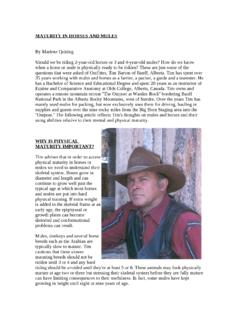Transcription of The 1913 Mule Riding Saddle - Maultier
1 1 von 4 The 1913 MULE Riding Saddle Without pack trains backing up every cavalry unit in the field, the cavalry could not long sustain itself. The primary beast of burden in the pack trains was the renown army mule but the mule was also the primary mount for the packers themselves - a tradition that went at least as far back in history as mule-mounted General George Crook of Indian War fame. Once a packer had selected a Saddle mule, that was its primary duty from then on. In 1913, for these Saddle mules, the army adopted a special mule Riding Saddle patterned on the M1904 McClellan Saddle - one with double rigging as well as a distinctive brass horn securely nailed into the pommel of the tree. However, what is little appreciated by most students of military saddles is that the M1913 Mule Riding Saddle was built on a specially-designed tree - one that varies in dimension and configuration from the standard M1904 tree.
2 Suffice to say, horses and Mules are built differently and the trees for their saddles reflect the differences. Fig, 1 shows a nice specimen of a M1913 Mule Riding Saddle but for one detail: the correct horsehair cinches are joined with a short leather strap that kept the cinchas from moving too far forward or Lack on the belly of the mule The proper, double cincha pair is shown in Fig. 2. Fig. 1 An off side view of a M1913 Mule Riding Saddle . The two girths are improper for this Saddle and the proper girths are shown in Fig. 2. The proper stirrups for this Saddle are the M1912 Stirrups in dark finish. 2 von 4 Fig. 2 - The regulation girths the M1913 Mule Riding Saddle . Note that these girths are of different width and have different size rings and safes. The off white cording is not mohair but is probably cotton or linen. Note that it is of the woven cord type that was also used during the period of the horsehair girths.
3 Steffens, in USMS, notes that breeching and breast harness were used on most mules - implying that this was the case with Saddle mules - but the authors do not feel that was common and, if the animal was as well trained as a horse, there was no need for breast strap or breeching. As noted above, the tree of the M1913 Mule Riding Saddle is entirely different from the tree of the standard cavalry Saddle designed to fit on horses. The M1913 is not only shaped differently but its widths and thicknesses differ markedly from that of the M1904. When finished to a Saddle seat, the differences are still quite pronounced. The first and most obvious difference between the M1913 and the standard M1904 seats is that of the curvature of the side bars. The arc of the sidebars of the M1913 (Fig. 3) is much more pronounced (wasp-waisted) when compared to the M1904. The width of the sidebars of both seats measure 4" at their narrowest but the width of the M1913 is 3/4" wider at the front and rear of the side bars.
4 Fig. 3 A closeup of the distinctly wasp-waisted side bar curvature on the M1913 3 von 4 The second major variance between the M1913 and M1904 seats is the shape of the rear side bars. As shown in Fig. 4, the M1913 has a much wider side bar at the rear as well as its being only a gradual curve up to the back arc of the seat. The M1904 has a shorter, much more curved rear side bar, resulting in a narrower seat. The final obvious difference in the seats is the shape of the cutout at the rear arc of the two seats (Fig. 4) . The M1913 has a sharp notch or 90 degree cut where the rear of the side bar turns back toward the saddlebag stud. The M1904 side bar, by comparison, has a continuous curve that finally meets the arc of the back of the seat. Unknown to most collectors is another major difference between the M1913 Mule Riding Saddle and the common M1904. Under the leather covering the top of the pommel arch and the top of the cantle arch, lies a large, contoured block of brass.
5 It is unknown what purpose was intended with these two blocks of brass (whether for balance, strength or both but their weight adds materially to the Saddle seat and the bulk they add almost doubles the thickness Of the pommel and cantle arches. The M1913 is not a common Saddle , particularly in the original configuration Many have been clumsily single rigged for Saddle horses and, almost always, the correct pair of strap-attached girths are missing. But, in its correct configuration, the M1913 Mule Riding Saddle is a unique, attractive and comfortable Saddle that is not commonly seen in collections. Fig. 4 - This closeup photo compares the rear sidebar areas of the regulation Second Pattern M1904 McClellan on the left and the M1913 Mule Riding Saddle on the right. These two seats differ markedly. The rear ends of the sidebars of the M1913 are much less curved than those of the M1904 and the angle of the sidebar and the cantle arc is much more abrupt, the M1913 forms a sharp "notch" as the sidebars turn back toward the saddlebag stud area.)
6 4 von 4 THE MODEL 1913 McCLELLAN MULE Riding Saddle (No Specimen Tree Available) The tree on this Saddle is distantly different from that of the Second Model 1904 McClellan. The tree of the M1913, though constructed in a manner similar to the M1904, has several important differences. First, the angle of the underside of the tree is constructed to fit the wider back of the American Mule, not a horse. This means that the sidebars of the M1913 flare outward more on their lower edges. Second, the shape of the rear of the sidebars of the M1913 does not give the rounded appearance of the M1904 but, though somewhat rounded, is sharply notched back toward the back of the cantle. Third, the sidebars of the M1904 extend almost 3/4" further rearward than do those of the M1913. Fourth, the sidebars of the M1913 are noticeably more wasp waisted than those of the M1904. A typical M1913 sidebar, at its narrowest, measures about 3 13/16" in width while the typical M1904 measures about 4 5/8" at the same point - a variance of about 1 3/16".
7 Fifth, all M1913 Mule Riding Saddle trees are the same size (hence no size markings). Sixth, the pommel - with its brass horn - is not mortised for a coat strap. Finally, and not so obviously, the pommel and cantle arches are much thicker than those on a M1904 tree. The reason for this is that each arch has a large, contoured block of brass mounted there. While these brass blocks have the effect of strengthening and stabilizing the seat on the mule, the authors have been unable to find documentation on the army's stated purpose for this construction. TIIE M1913 DOUBLE CINCHA FOR THE MULE Riding Saddle The double cincha system for the army mule Riding Saddle preceded the double cincha system for the packers Riding saddles . In the 1914-dated Rock Island Arsenal photo showing the M1913 Double Cincha for the Mule Riding Saddle , the white woven cotton cord construction of the early girths show clearly.
8 (See Fig. 2 above) Aus The American Military Saddle , 1776-1945 , Seiten 119, 120, 186 und 247






